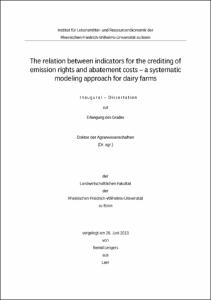The relation between indicators for the crediting of emission rights and abatement costsa systematic modeling approach for dairy farms

The relation between indicators for the crediting of emission rights and abatement costs
a systematic modeling approach for dairy farms

| dc.contributor.advisor | Holm-Müller, Karin | |
| dc.contributor.author | Lengers, Bernd | |
| dc.date.accessioned | 2020-04-18T13:30:29Z | |
| dc.date.available | 2020-04-18T13:30:29Z | |
| dc.date.issued | 18.12.2013 | |
| dc.identifier.uri | https://hdl.handle.net/20.500.11811/5560 | |
| dc.description.abstract | With the Kyoto Protocol, industrial nations agreed to reduce greenhouse gas (GHG) emissions compared to the 1990 level. Therefore, in Europe, the emissions trading scheme (ETS) was implemented, to date incorporating industrial sectors and aviation. Agriculture is up to now only included in the reporting mechanisms for national GHG inventories. In Germany, the agricultural sector emissions accounted for 5.6% of the national total in 2007. The questions therefore arise, whether and how agriculture may contribute to the national reduction goals. For market-based instruments (like the ETS), the emission inventories of participants need to be quantifiable. However, since most agricultural GHGs originate from diffuse sources, they cannot be measured directly and therefore have to be derived by calculation schemes (indicators) which use farm-level data to approximate the actual emissions. Though, the construction of the indicators determines which farm-level information are accessed for calculation. This directly impacts which GHG mitigation options are accounted by the indicator. Hence, it can be assumed that the indicator construction impacts on the accuracy of GHG accounting, the indicators’ feasibility on single farms and in a political context, as well as the ability to induce low-cost abatement strategies on farm level. To investigate these aspects, a highly detailed single farm, mixed integer linear programming model was developed which is adjustable to a wide range of dairy farm characteristics and a set of promising GHG indicators. It enables single farm abatement and marginal abatement costs (MACs) for the mitigation of GHGs to be derived and compared using different detailed indicators. Further on, a meta-modeling approach was used to derive statistical dependencies between farm characteristics, prices, factors of a potential environmental policy design (targeted reduction level, accounting period, indicator…) and the simulated MACs. By influencing the ability of choosing abatement measures at a farm level, the indicators show a strong impact on the level of the resulting MACs. Detailed indicators allow for low-cost abatement for low reduction levels, but the cost advantages of detailed indicators level off with increasing abatement amounts. The results indicate that the more detailed the indicator definition is, the higher the GHG accounting accuracy also is. The feasibility of such indicators at a farm level as well as on the political level on the other hand decreases in complexity of indicator definition. A great trade-off was found between feasibility of indicators and the other requirements of measurement accuracy and low-cost abatement. Furthermore, a variety of farm characteristics and prices show significant impacts on the MACs which points to highly heterogeneous MAC structures in the actual farm population. Thus, the predictability of potential abatement amounts and resulting cost burdens in the farm population deteriorates. In addition, MACs in dairy farming are relatively high compared to other sectors and cost effective abatement amounts in a price relevant range (with regard to actual carbon prices) are up to now only achievable with a rather small potential under detailed indicators which induce high administrative burdens. Hence, to date, cost efficient GHG mitigation in dairy farming is hardly achievable under market-based instruments. Statutory requirements in line with existing building or environmental regulations may be the more meaningful solution and gain synergy effects. Nevertheless, further, more detailed analyses regarding these issues are required. Whereat, this work has shown that the environmental policy instrument, the sectoral reduction goals, and especially the applied GHG indicator are topics not to be discussed separately in the discussion about possible and cost efficient abatement possibilities in agriculture. Therefore, the obtained results and developed modeling and analytical approaches can deliver good starting points. | en |
| dc.language.iso | eng | |
| dc.rights | In Copyright | |
| dc.rights.uri | http://rightsstatements.org/vocab/InC/1.0/ | |
| dc.subject | Treibhausgase | |
| dc.subject | Emissionsberechnung | |
| dc.subject | Betriebsmodellierung | |
| dc.subject | Milchviehhaltung | |
| dc.subject | THG-Indikatoren | |
| dc.subject | THG-Vermeidungskosten | |
| dc.subject | greenhouse gases | |
| dc.subject | emission accounting | |
| dc.subject | farm modeling | |
| dc.subject | dairy farming | |
| dc.subject | GHG indicators | |
| dc.subject | GHG abatement costs | |
| dc.subject.ddc | 630 Landwirtschaft, Veterinärmedizin | |
| dc.title | The relation between indicators for the crediting of emission rights and abatement costs | |
| dc.title.alternative | a systematic modeling approach for dairy farms | |
| dc.type | Dissertation oder Habilitation | |
| dc.publisher.name | Universitäts- und Landesbibliothek Bonn | |
| dc.publisher.location | Bonn | |
| dc.rights.accessRights | openAccess | |
| dc.identifier.urn | https://nbn-resolving.org/urn:nbn:de:hbz:5n-34100 | |
| ulbbn.pubtype | Erstveröffentlichung | |
| ulbbnediss.affiliation.name | Rheinische Friedrich-Wilhelms-Universität Bonn | |
| ulbbnediss.affiliation.location | Bonn | |
| ulbbnediss.thesis.level | Dissertation | |
| ulbbnediss.dissID | 3410 | |
| ulbbnediss.date.accepted | 08.11.2013 | |
| ulbbnediss.fakultaet | Landwirtschaftliche Fakultät | |
| dc.contributor.coReferee | Heckelei, Thomas |
Dateien zu dieser Ressource
Das Dokument erscheint in:
-
E-Dissertationen (1118)




